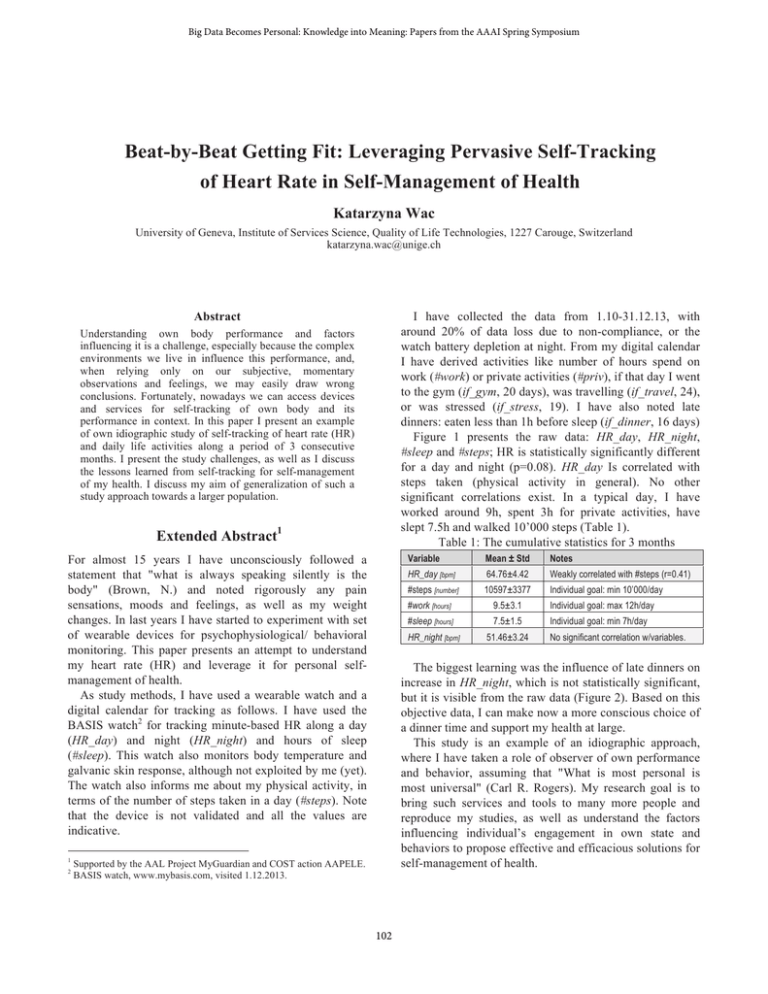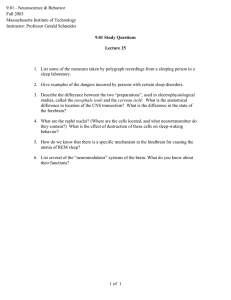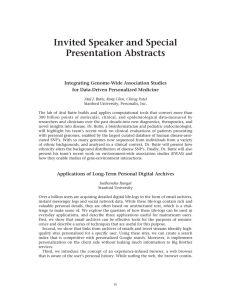Katarzyna Wac
advertisement

Big Data Becomes Personal: Knowledge into Meaning: Papers from the AAAI Spring Symposium Beat-by-Beat Getting Fit: Leveraging Pervasive Self-Tracking of Heart Rate in Self-Management of Health Katarzyna Wac University of Geneva, Institute of Services Science, Quality of Life Technologies, 1227 Carouge, Switzerland katarzyna.wac@unige.ch Abstract I have collected the data from 1.10-31.12.13, with around 20% of data loss due to non-compliance, or the watch battery depletion at night. From my digital calendar I have derived activities like number of hours spend on work (#work) or private activities (#priv), if that day I went to the gym (if_gym, 20 days), was travelling (if_travel, 24), or was stressed (if_stress, 19). I have also noted late dinners: eaten less than 1h before sleep (if_dinner, 16 days) Figure 1 presents the raw data: HR_day, HR_night, #sleep and #steps; HR is statistically significantly different for a day and night (p=0.08). HR_day Is correlated with steps taken (physical activity in general). No other significant correlations exist. In a typical day, I have worked around 9h, spent 3h for private activities, have slept 7.5h and walked 10’000 steps (Table 1). Table 1: The cumulative statistics for 3 months Understanding own body performance and factors influencing it is a challenge, especially because the complex environments we live in influence this performance, and, when relying only on our subjective, momentary observations and feelings, we may easily draw wrong conclusions. Fortunately, nowadays we can access devices and services for self-tracking of own body and its performance in context. In this paper I present an example of own idiographic study of self-tracking of heart rate (HR) and daily life activities along a period of 3 consecutive months. I present the study challenges, as well as I discuss the lessons learned from self-tracking for self-management of my health. I discuss my aim of generalization of such a study approach towards a larger population. Extended Abstract1 For almost 15 years I have unconsciously followed a statement that "what is always speaking silently is the body" (Brown, N.) and noted rigorously any pain sensations, moods and feelings, as well as my weight changes. In last years I have started to experiment with set of wearable devices for psychophysiological/ behavioral monitoring. This paper presents an attempt to understand my heart rate (HR) and leverage it for personal selfmanagement of health. As study methods, I have used a wearable watch and a digital calendar for tracking as follows. I have used the BASIS watch2 for tracking minute-based HR along a day (HR_day) and night (HR_night) and hours of sleep (#sleep). This watch also monitors body temperature and galvanic skin response, although not exploited by me (yet). The watch also informs me about my physical activity, in terms of the number of steps taken in a day (#steps). Note that the device is not validated and all the values are indicative. 1 2 Variable Mean ± Std Notes HR_day [bpm] 64.76±4.42 Weakly correlated with #steps (r=0.41) #steps [number] 10597±3377 Individual goal: min 10’000/day #work [hours] 9.5±3.1 Individual goal: max 12h/day #sleep [hours] 7.5±1.5 Individual goal: min 7h/day HR_night [bpm] 51.46±3.24 No significant correlation w/variables. The biggest learning was the influence of late dinners on increase in HR_night, which is not statistically significant, but it is visible from the raw data (Figure 2). Based on this objective data, I can make now a more conscious choice of a dinner time and support my health at large. This study is an example of an idiographic approach, where I have taken a role of observer of own performance and behavior, assuming that "What is most personal is most universal" (Carl R. Rogers). My research goal is to bring such services and tools to many more people and reproduce my studies, as well as understand the factors influencing individual’s engagement in own state and behaviors to propose effective and efficacious solutions for self-management of health. Supported by the AAL Project MyGuardian and COST action AAPELE. BASIS watch, www.mybasis.com, visited 1.12.2013. 102 90" 25000" 80" 20000" 70" 60" 15000" 50" 40" 10000" 30" 20" 5000" 10" 0" 0" 1" 3" 5" 7" 9" 11" 13" 15" 17" 19" 21" 23" 25" 27" 29" 31" 33" 35" 37" 39" 41" 43" 45" 47" 49" 51" 53" 55" 57" 59" 61" 63" 65" 67" 69" 71" 73" 75" 77" 79" 81" 83" 85" steps" sleep_hr" HR"avg"night" HR"avg"day" Figure 1: Heart Rate and Activities Raw Data and its Distribution (Whole Study) Figure 2: Example minute-by-minute HR at night for a) late dinner (top) b) early dinner (bottom) 103






